Electrically Tunable Metasurface for Multi-Polarized Reflection
Abstract
1. Introduction
2. Metasurface’s Unit Cell Design
3. Simulation Result
3.1. Unit Cell Simulation
3.2. 10 × 10 Array Simulation
4. Conclusions
Author Contributions
Funding
Data Availability Statement
Conflicts of Interest
References
- Wang, E.W.; Yu, S.J.; Phan, T.; Dhuey, S.; Fan, J.A. Arbitrary Achromatic Polarization Control with Reconfigurable Metasurface Systems. Laser Photonics Rev. 2023, 17, 2200926. [Google Scholar] [CrossRef]
- Shao, L.; Li, Z.; Feng, J.; Zhang, J.; Shi, H.; Bai, X.; Zhu, W. Transmissive Metasurface for Multi-Channel and Full-Polarization Modulation of Electromagnetic Wavefronts. Photonics Res. 2023, 11, 245–251. [Google Scholar] [CrossRef]
- Pramanik, S.; Bakshi, S.C.; Koley, C.; Mitra, D.; Monti, A.; Bilotti, F. Active Metasurface-Based Reconfigurable Polarization Converter with Multiple and Simultaneous Functionalities. IEEE Antennas Wirel. Propag. Lett. 2023, 22, 522–526. [Google Scholar] [CrossRef]
- Baghel, A.K.; Kulkarni, S.S.; Nayak, S.K. Linear-to-Cross-Polarization Transmission Converter Using Ultrathin and Smaller Periodicity Metasurface. IEEE Antennas Wirel. Propag. Lett. 2019, 18, 1433–1437. [Google Scholar] [CrossRef]
- Li, W.; Ma, Q.; Liu, C.; Zhang, Y.; Wu, X.; Wang, J.; Gao, S.; Qiu, T.; Liu, T.; Xiao, Q.; et al. Intelligent Metasurface System for Automatic Tracking of Moving Targets and Wireless Communications Based on Computer Vision. Nat. Commun. 2023, 14, 989. [Google Scholar] [CrossRef] [PubMed]
- Li, S.J.; Han, B.W.; Li, Z.Y.; Liu, X.B.; Huang, G.S.; Li, R.Q.; Cao, X.Y. Transmissive Coding Metasurface with Dual-Circularly Polarized Multi-Beam. Opt. Express 2022, 30, 26362–26376. [Google Scholar] [CrossRef] [PubMed]
- Zhang, K.; Wang, Y.; Burokur, S.N.; Wu, Q. Generating Dual-Polarized Vortex Beam by Detour Phase: From Phase Gradient Metasurfaces to Metagratings. IEEE Trans. Microw. Theory Tech. 2022, 70, 200–209. [Google Scholar] [CrossRef]
- Wang, C.; Pang, M.; Zhong, D.; Cui, Y.; Wang, W. A MmWave Communication Testbed Based on IEEE 802.11ad with Scalable PtMP Configuration. China Commun. 2022, 19, 44–56. [Google Scholar] [CrossRef]
- Xu, B.; Zhou, T.; Gao, F.; Xu, T.; Hu, H. RIS-Aided MIMO Communications: Angle-Dependent Amplitude-Phase Response Model and Capacity Analysis. IEEE Wirel. Commun. Lett. 2024, 14, 290–294. [Google Scholar] [CrossRef]
- Gao, W.H.; Chen, M.; Cheng, Q.; Cui, T.J. A 1-Bit Coding Metasurface with Polarization Conversion in X-Band. Front. Mater. 2022, 9, 914937. [Google Scholar] [CrossRef]
- Shi, H.; Liu, R.; Zhang, Z.; Chen, X.; Wang, L.; Yi, J.; Liu, H.; Zhang, A. A Dual-Polarized Reflective Reconfigurable Metasurface with Stable Amplitude Based on Guided-Wave-Driven Structure. IEEE Antennas Wirel. Propag. Lett. 2024, 23, 1720–1724. [Google Scholar] [CrossRef]
- Hassan, A.G.; Sumaid, M.; Ahmed, F.; Shoaib, N.; Abbasi, Q.H.; Nikolaou, S. Reconfigurable Absorptive and Polarization Conversion Metasurface Consistent for Wide Angles of Incidence. Sci. Rep. 2023, 13, 18209. [Google Scholar] [CrossRef] [PubMed]
- Wang, J.; Shi, H.; Chen, X.; Yi, J.; Chen, J.; Zhang, A.; Liu, H. A Second-Order Cross-Polarization Conversion Metasurface with High Frequency Selectivity. IEEE Antennas Wirel. Propag. Lett. 2023, 22, 3077–3081. [Google Scholar] [CrossRef]
- Cerveny, M.; Ford, K.L.; Tennant, A. Reflective Switchable Polarization Rotator Based on Metasurface with PIN Diodes. IEEE Trans. Antennas Propag. 2021, 69, 1483–1492. [Google Scholar] [CrossRef]
- Yang, H.; Wang, S.C.; Li, P.; He, Y.; Zhang, Y.J. A Broadband Multifunctional Reconfigurable Polarization Conversion Metasurface. IEEE Trans. Antennas Propag. 2023, 71, 5759–5767. [Google Scholar] [CrossRef]
- Liu, W.; Ke, J.C.; Xiao, C.; Zhang, L.; Cheng, Q.; Cui, T.J. Broadband Polarization-Reconfigurable Converter Using Active Metasurfaces. IEEE Trans. Antennas Propag. 2023, 71, 3725–3730. [Google Scholar] [CrossRef]
- Zheng, Q.; Guo, C.; Vandenbosch, G.A.E.; Yuan, P.; Ding, J. Dual-Broadband Highly Efficient Reflective Multi-Polarisation Converter Based on Multi-Order Plasmon Resonant Metasurface. IET Microw. Antennas Propag. 2020, 14, 967–972. [Google Scholar] [CrossRef]
- Chen, Q.; Cheng, Y.F.; Shao, C.H.; Feng, J.; Liao, C.; Ding, X. A High-Gain Dual-Band Shared-Aperture Array Integrating Zero-Order-Resonance Patch and Higher-Order Metasurface Antenna. Sci. Rep. 2023, 13, 11647. [Google Scholar] [CrossRef] [PubMed]
- Chen, H.; Zhao, W.; Gong, X.; Du, L.; Cao, Y.; Zhai, S.; Song, K. Multi-Band High-Efficiency Multi-Functional Polarization Controller Based on Terahertz Metasurface. Nanomaterials 2022, 12, 3189. [Google Scholar] [CrossRef] [PubMed]
- Bo, X.Z.; Chen, H.; Yu, B.Y.; Geng, M.Y.; Liu, Z.G.; Lu, W.B. A Flexible and Transparent Broadband Metasurface Polarization Converter. IEEE Antennas Wirel. Propag. Lett. 2024, 23, 1311–1315. [Google Scholar] [CrossRef]
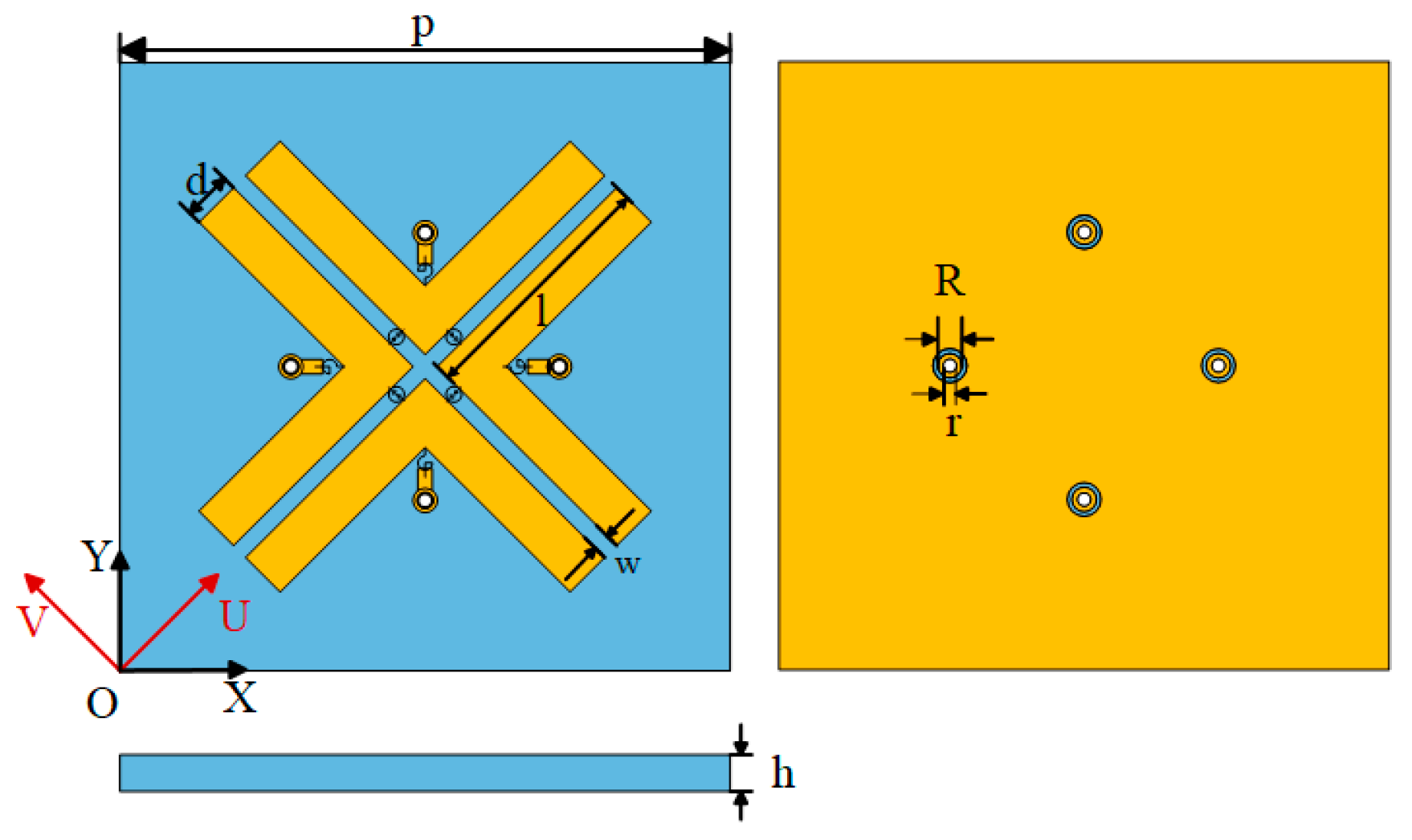
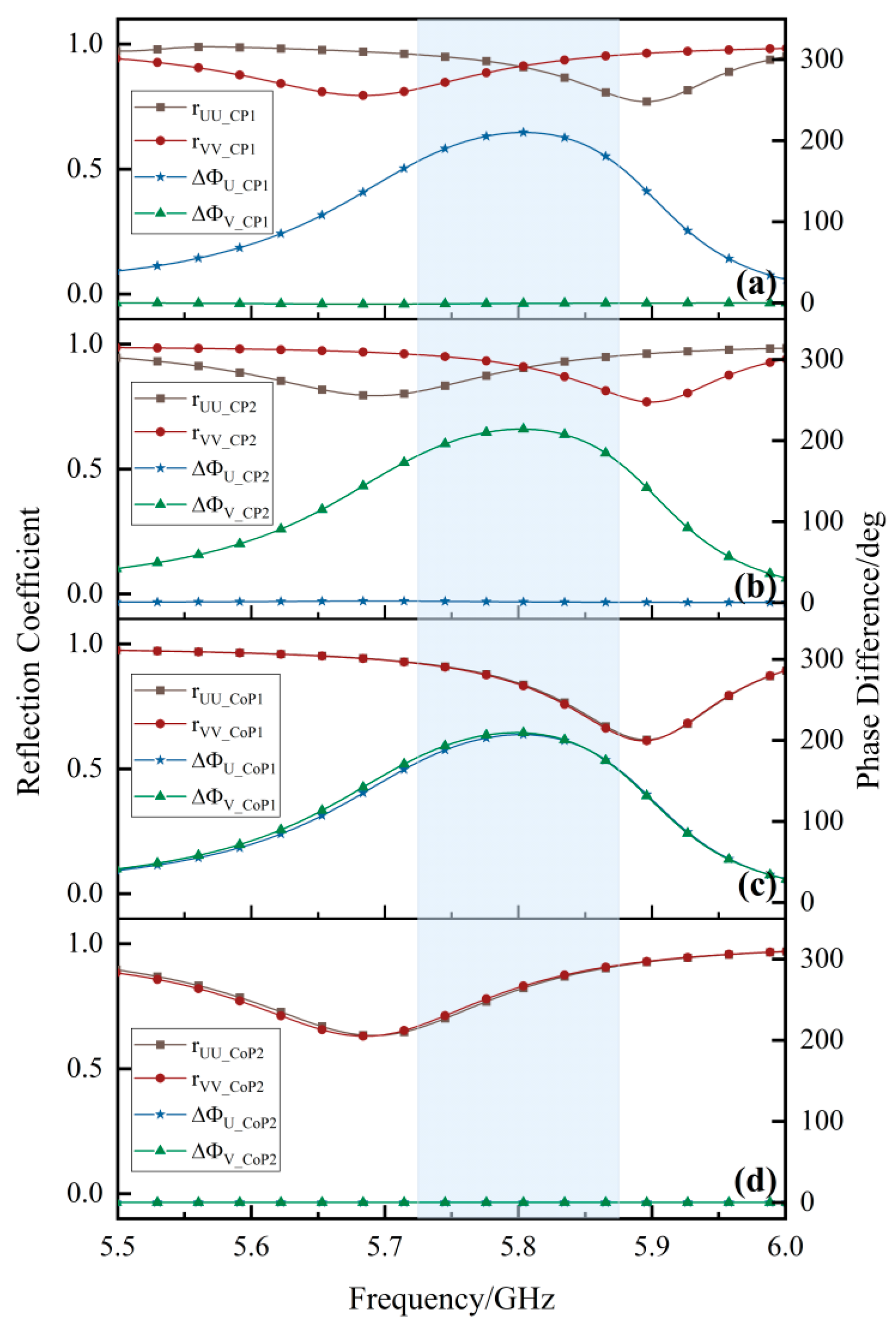
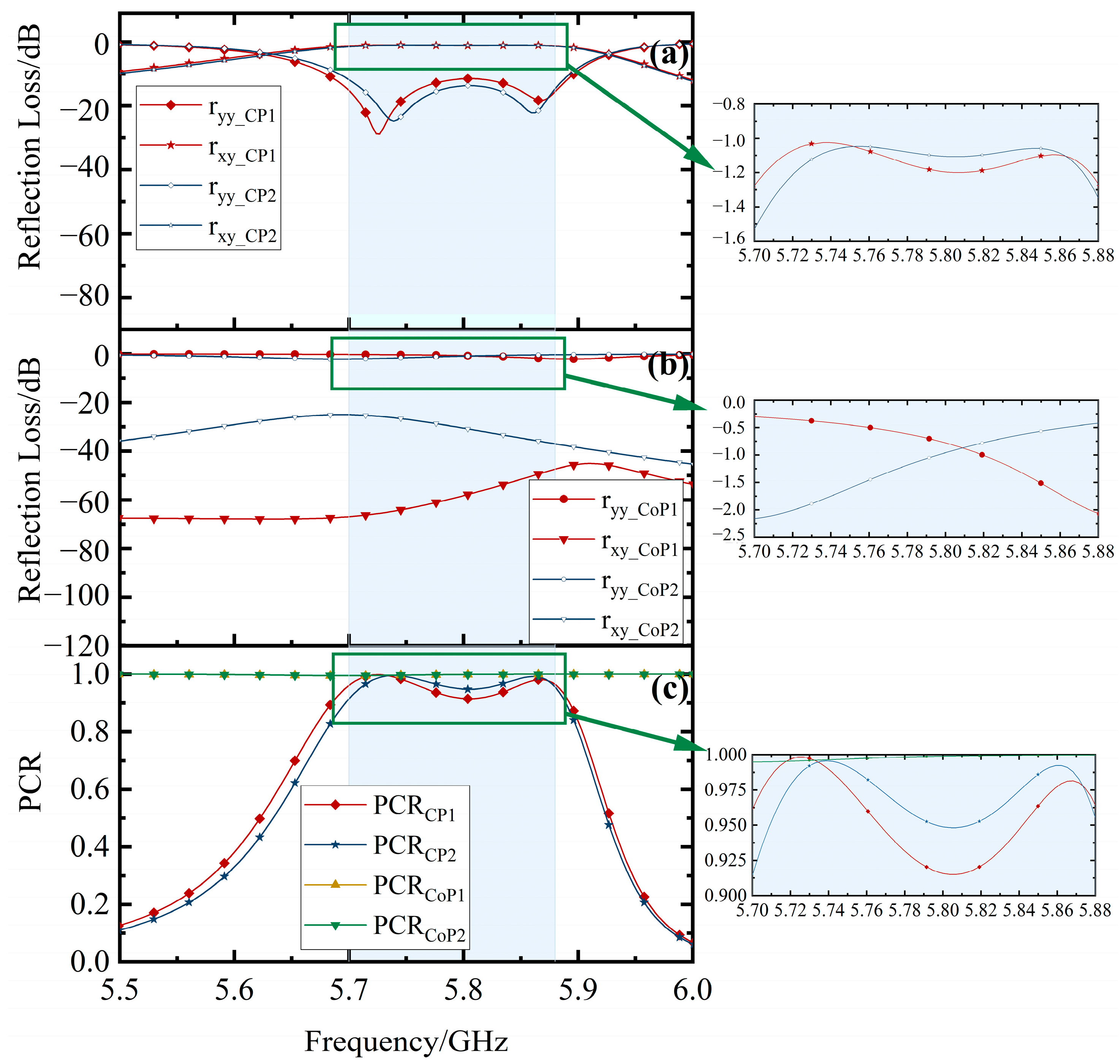
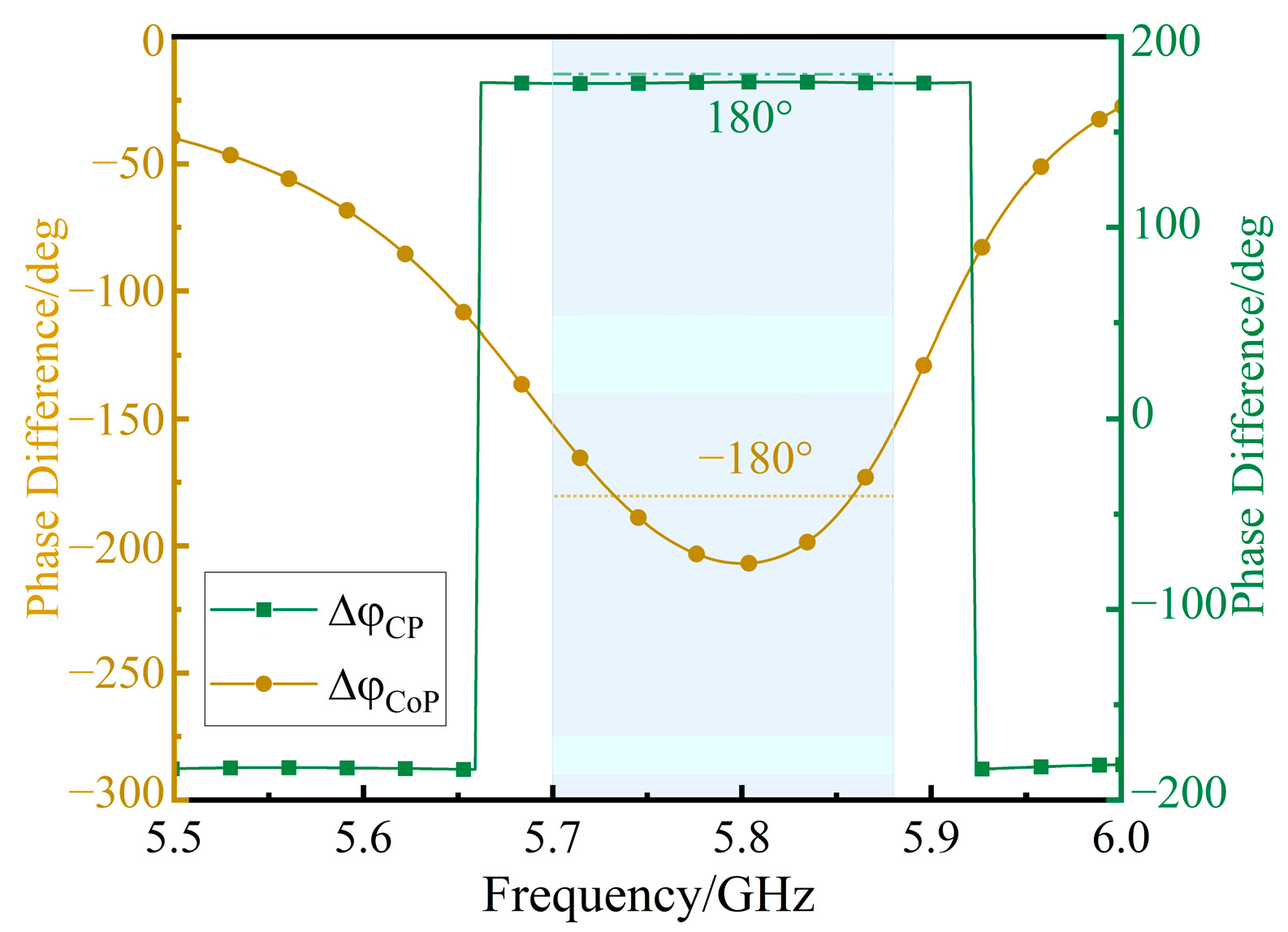
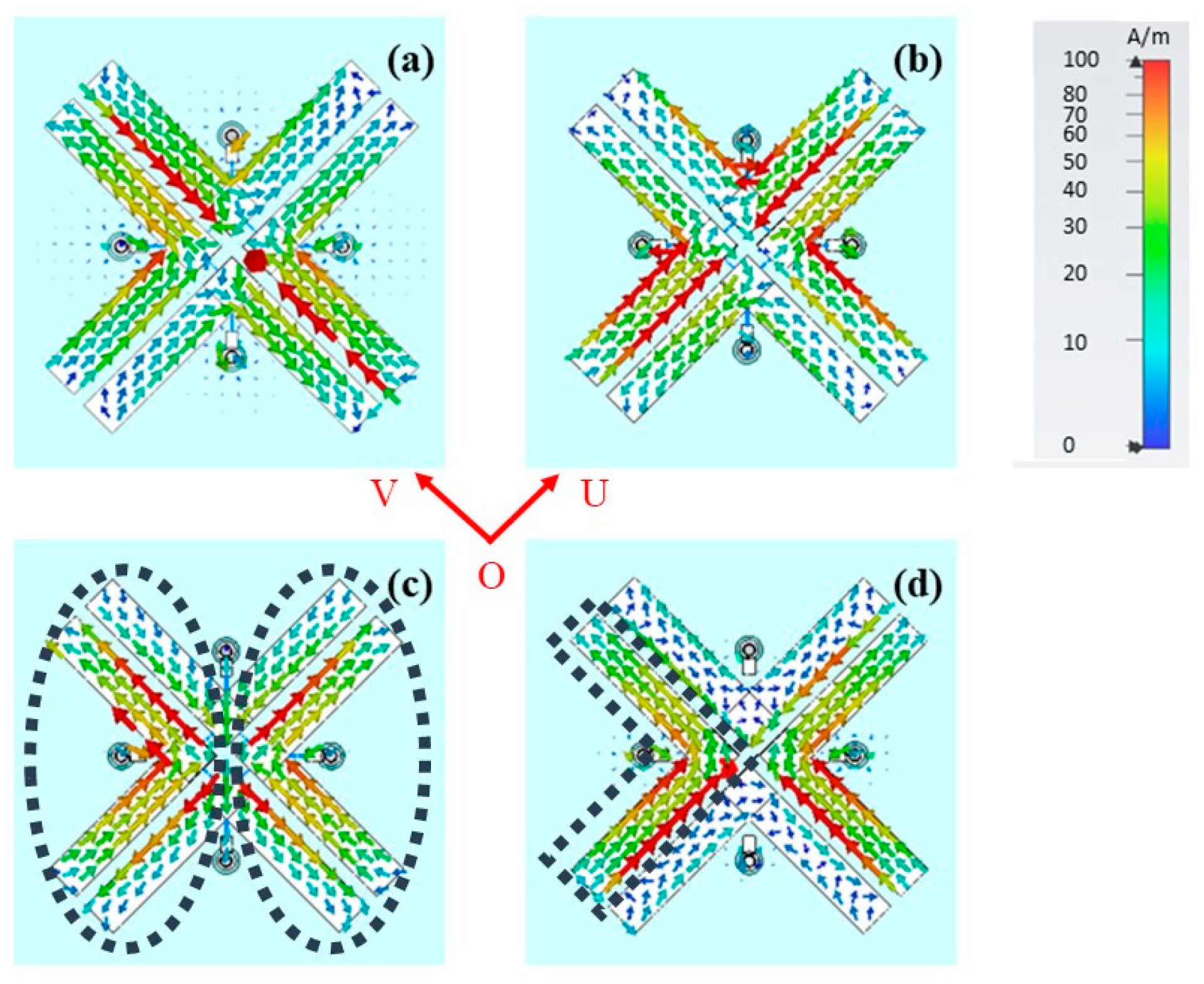
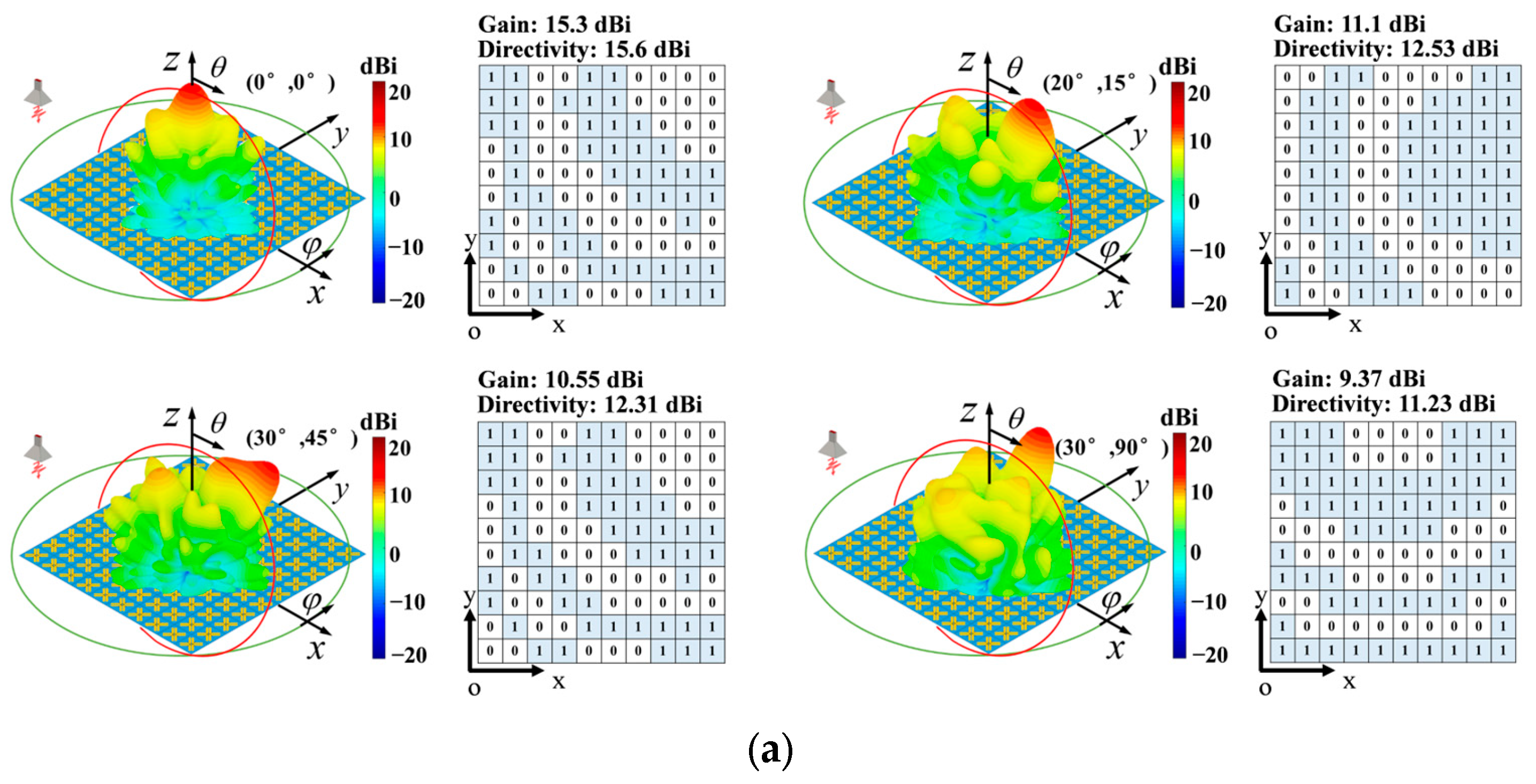
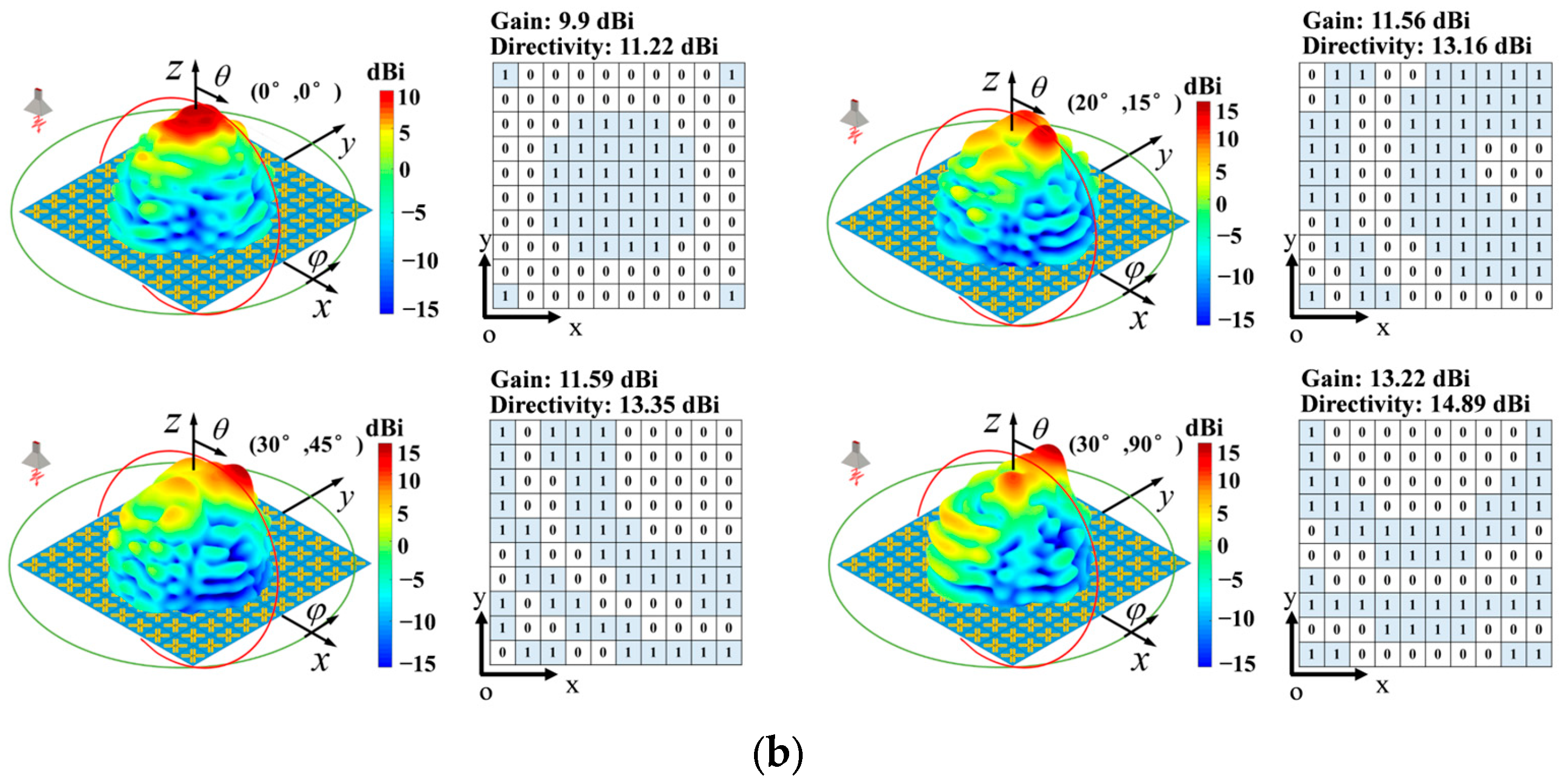
| Ref. | Frequency (GHz) | Function | Substrate Thickness (mm) | Conversion Performance | Beam-Shaping Deflection Angle (degree) |
|---|---|---|---|---|---|
| [8] | 10.04–10.36 | Cross-polarization conversion, 1-bit phase control | 5.3 | Loss(CP *) < 1 dB PCR(CP *): Not given | Not given |
| [9] | 2.6 | Cross-polarization conversion without phase control | 4 | Loss(CP *) < 1.5 dB PCR(CP *): Not given | ±60° |
| [10] | 5.4 | Cross-polarization conversion without phase control | 3.2 | Loss(CP *): Not given PCR(CP *) > 0.95 | Not given |
| [11] | 2.65 | Cross-polarization conversion without phase control | 3.035 | Loss(CP *): Not given PCR(CP *) ≤ 0.9993 | Not given |
| [12] | CP: 3.77–6.20 | Cross-polarization conversion, co-polarization conversion, linear to circular polarization conversion without phase control | 5.4 | Loss(CP *): Not given PCR(CP *) > 0.9 Loss(CoP *) < 1 dB PCR(CoP *): Not given Loss(LC *): Not given PCR(LC *): Not given | Not given |
| [13] | 4.8–6.2 | Cross-polarization conversion, 1-bit phase control | 6.4 | Loss(CP *): Nearly 0 dB PCR(CP *): Not given | Not given |
| [3] | CP *: 6.05–14.76 | Cross-polarization conversion, linear to circular polarization conversion without phase control | 4.4 | Loss(CP *): Not given PCR(CP *) > 0.9 Loss(LC *): Not given PCR(LC *): Not given | Not given |
| [14] | 7.4–12 | Cross-polarization conversion and co-polarization conversion for linear and circular polarized waves without phase control | 2.9 | Loss(CP *) < 1 dB PCR(CP *): Not given Loss(CoP *) < 1 dB PCR(CoP *): Not given Loss(CC *) < 1 dB PCR(CC *): Not given Loss(CoC *) < 1 dB PCR(CoC *): Not given | Not given |
| [15] | CP *: 7.74–14.44 | Cross-polarization conversion, linear to circular polarization conversion without phase control | 3 | Loss(CP *): Not given PCR(CP *) > 0.9 Loss(LC *): Not given PCR(LC *): Not given | Not given |
| This work | 5.8 | Cross-polarization conversion, co-polarization conversion, 1-bit phase control | 1.6 | Loss(CP *): Nearly 1 dB PCR(CP *) > 0.91 Loss(CoP *) < 2 dB PCR(CoP *): Nearly 1 | CP *: ±45° CoP *: ±30° |
Disclaimer/Publisher’s Note: The statements, opinions and data contained in all publications are solely those of the individual author(s) and contributor(s) and not of MDPI and/or the editor(s). MDPI and/or the editor(s) disclaim responsibility for any injury to people or property resulting from any ideas, methods, instructions or products referred to in the content. |
© 2025 by the authors. Licensee MDPI, Basel, Switzerland. This article is an open access article distributed under the terms and conditions of the Creative Commons Attribution (CC BY) license (https://creativecommons.org/licenses/by/4.0/).
Share and Cite
Li, B.; Wang, Y.; Wang, C.; Liu, S. Electrically Tunable Metasurface for Multi-Polarized Reflection. Remote Sens. 2025, 17, 700. https://doi.org/10.3390/rs17040700
Li B, Wang Y, Wang C, Liu S. Electrically Tunable Metasurface for Multi-Polarized Reflection. Remote Sensing. 2025; 17(4):700. https://doi.org/10.3390/rs17040700
Chicago/Turabian StyleLi, Bing, Yunhan Wang, Chunan Wang, and Shiqi Liu. 2025. "Electrically Tunable Metasurface for Multi-Polarized Reflection" Remote Sensing 17, no. 4: 700. https://doi.org/10.3390/rs17040700
APA StyleLi, B., Wang, Y., Wang, C., & Liu, S. (2025). Electrically Tunable Metasurface for Multi-Polarized Reflection. Remote Sensing, 17(4), 700. https://doi.org/10.3390/rs17040700







